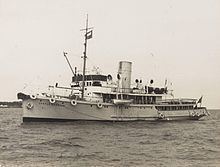Fate Sunk 16 October 1942 | Completed 1929 Launched 1929 | |
 | ||
Builder Blythswood Shipbuilding Co. Ltd Homeport Royal Naval Dockyard, Bermuda | ||
HMS Castle Harbour was a civilian harbour vessel of 730 tons that was taken-up from trade (TUFT) during the Second World War by the Royal Naval Dockyard in Bermuda for use by the Royal Naval Examination Service and later armed and commissioned as a warship, providing harbour defence from submarines.
Contents
Pre-War Civil History
Built by Blythswood Shipbuilding Co. Ltd in Glasgow, Scotland, for the Bermuda and West Indies Steamship Company (part of Furness-Withy) as the Mid-Ocean in 1929, Lieutenant-Commander Ian Stranack, in The Andrew And The Onions: The Story Of The Royal Navy In Bermuda, 1795–1975, described her as a tug. Other sources describe her as a tender, used to transport passengers between liners at an anchorage and the shore. Possibly she was used in both roles. She was used to service Furness-Withy liners that maintained passenger service between Bermuda and North America. She was renamed in 1930 in commemoration of Castle Harbour at the East End of Bermuda where Furness-Withy was building the Castle Harbour Hotel and the Mid-Ocean Golf Course on land forcibly appropriated from the inhabitants of Tucker's Town.
Royal Naval Examination service
With the outbreak of the Second World War in 1939, Castle Harbour was taken over by the Royal Naval Examination Service (RNXS). Ships arriving at Bermuda were obliged to stop at Five-Fathom Hole, which had been designated the Examination Anchorage. This body of water lies just within the outer reefline, and ships can travel from it directly into St. George's Harbour, or can follow Hurd's Channel around St. Catherine's Point to reach the Northern Lagoon, enclosed by the barrier reef. From here, ships can enter the Great Sound, where the North America and West Indies Station anchorage is located at Grassy Bay (east of the Royal Naval Dockyard on Ireland Island and west of Spanish Point on the Main Island, where the Admiralty House was located. The Great Sound was also the landing area used by Royal Air Force and airline flying boats operating from Darrell's Island and Fleet Air Arm seaplanes operating from the Royal Naval Air Station on Boaz Island (the US Navy began building a third flying boat air station, combined with naval docklands, the US Naval Operating Base, on the Great Sound even before the US entry into the war). During the course of the war, when Allied trans-Atlantic shipping was organised into convoys, Bermuda became a forming up point for convoys (coded BHX, these joined at sea with HX-coded convoys from Halifax to complete the passage to Europe), with large numbers of vessels anchoring on the Northern Lagoon and the Great Sound. From the Great Sound, ships could also reach Bermuda's main commercial port, the City of Hamilton, on Hamilton Harbour.
All of these sites were inviting targets for German naval vessels, raiding parties, saboteurs, and spies. The RNXS was tasked with sending a naval examiner along with the civil government pilot who would steer arriving vessels through the reefs. Only after the examiner had cleared the vessel would the pilot steer it inwards. St. David's Battery, on the cliffs of St. David's Head, was designated Examination Battery during the war, with its gunners ready to fire upon any vessel that attempted to move from the anchorage without authorisation.
Castle Harbour, which at this point remained on the civil register, was used to deliver the naval examiner and pilot to arriving ships. She herself was crewed by a mix of merchant seamen and local service Royal Naval ratings.
HMS Castle Harbour
As the war progressed, and the threat of German submarines became acute, Castle Harbour's role was expanded. She was refitted, armed with a 3-inch gun on the bow, four machine guns and sixteen depth charges, and commissioned as HMS Castle Harbour. Crewed mostly by local-service ratings, she was tasked with anti-submarine patrols within the reefline to prevent attacks like that carried out at Scapa Flow by the German submarine U-47 under the command of Günther Prien on the 14 October 1939. It was also thought German submarines might be used to land raiding parties, saboteurs, or spies. Outside the reefs, Charles Fairey's similarly converted yacht carried our anti-submarine patrols as HMS Evadne.
Loss
By late 1942, the threat of enemy submarines in the area had so diminished that HMS Castle Harbour was deemed unnecessary at Bermuda. She was consequently ordered to the Mediterranean. She was travelling as part of Convoy TRIN-19 from Trinidad, evidently with a Merchant Navy crew, when at 2120 hours on 16 October 1942, she was torpedoed by the German submarine U-160. The explosion broke her in two and she sank within twenty seconds with the loss of nine of her twenty-two crewmembers.
